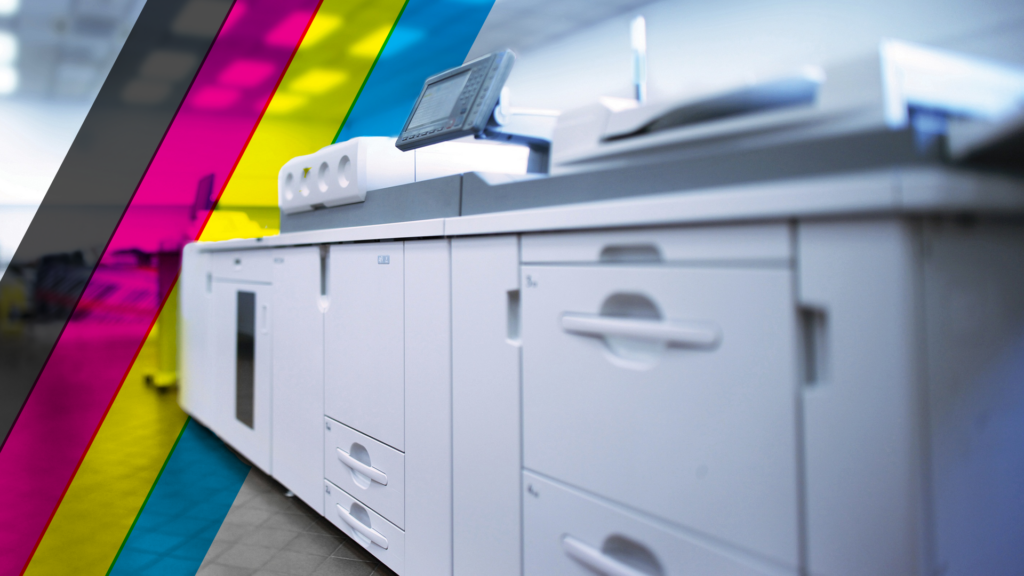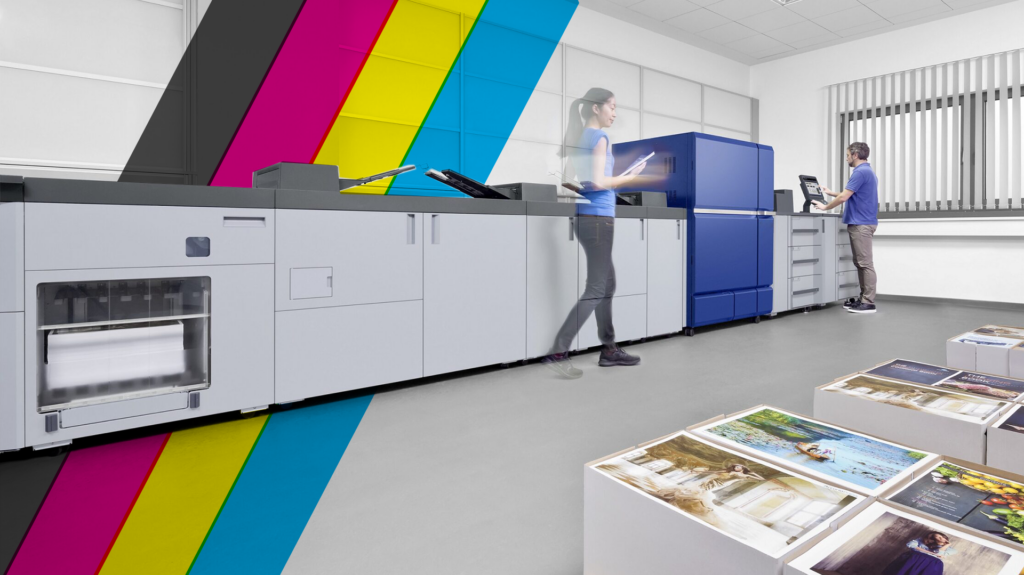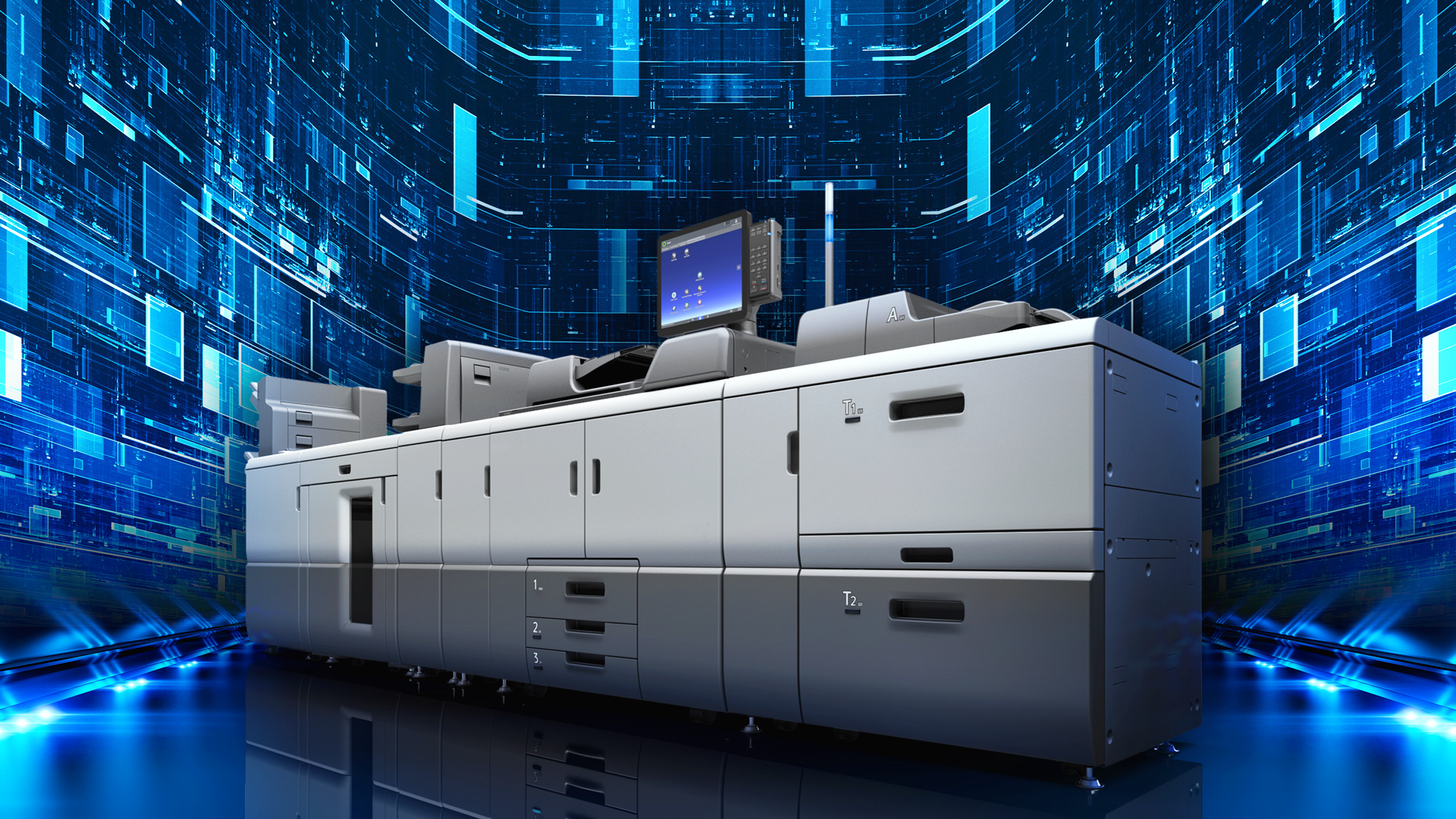The demand for print services within enterprise organizations has not shrunk at all. In fact, the printing demand within healthcare enterprise organizations has grown 28% since the peak of the pandemic. From marketing collateral to operational documents, the demand for high-quality printing is ever-present. As enterprise organizations consider streamlining their print operations, bringing production print in-house should definitely be a strategy to consider.
RELATED: The benefits of bringing production print in-house
Not a lot of time? Skip to what you need
- What Is Production Print?
- How a Production Printer Differs from an Ordinary Laser Printer
- Cost Considerations
- The Strategic Benefits of In-House Production Printing
- What You Should Know About Production Printers
- Integrating Production Print with Managed Print Services (MPS)
- Make In-House Production Print Work for Your Organization
What Is Production Print?
Production printing refers to high-volume, high-speed printing performed by advanced printers. One might say that a production printer compares to a consumer printer the way a train compares to a commuter car. These devices are physically much larger than the average consumer inkjet or laser printer. They are capable of producing a wide range of printed materials, including brochures, catalogs, direct mail, and large-scale documents, with exceptional quality and efficiency. While standard office printers are designed for occasional use, production printers are intended for durability and reliability under constant, rigorous use.
How a Production Printer Differs from an Ordinary Laser Printer
The primary difference between standard office equipment and production printers is their rugged durability. While a laser printer is suitable for everyday office printing tasks, a production printer can deliver a much larger volume with speed and high quality. Additionally, production printers support a wider range of media types and sizes, offer superior image quality with higher resolution, and include advanced finishing options like folding, binding, and trimming, which are beyond the scope of standard laser printers.
Cost Considerations
Original Purchase
Initially, a production printer represents a significant investment, often costing substantially more than standard laser printers. Prices can range from $20,000 to over $200,000, depending on the printer’s capabilities and features. However, this investment is justified by the printer’s longevity, efficiency, and quality of output.
Ongoing Costs
When one considers throughput, renewables, maintenance, and other ongoing costs, a production printer can represent substantial savings year-over-year due to their higher efficiency and lower cost per page. While the ink or toner for production printers may have a higher upfront cost, their cartridges produce a significantly higher yield, reducing the cost per print, especially at high volumes. Additionally, by eliminating the markups associated with outsourcing, in-house production printing drives long-term expenses even lower.

The Strategic Benefits of In-House Production Printing
The decision to bring production printing in-house represents a strategic shift towards greater operational efficiency, security, and market responsiveness for enterprise organizations. This move not only aligns with cost management strategies but also enhances the organization’s agility and brand integrity. Here, we explore the multifaceted benefits of this decision.
- Flexibility and Control: Bringing production printing in-house offers organizations complete control over their printing needs, allowing for immediate adjustments, customizations, and corrections. This flexibility ensures that materials can be tailored for specific audiences or events without the lead times required by external vendors.
- Enhanced Security: For organizations that deal with confidential or sensitive materials, the security benefits of in-house production printing cannot be overstated. In-house production printing keeps sensitive materials on-site, significantly reducing the risk of data breaches and information leaks associated with external vendors – safeguarding the organization’s reputation and intellectual property.
- Cost Efficiency: In-house production printing can significantly reduce costs over time. By eliminating external vendor fees and controlling waste, organizations can benefit from a lower cost per print, especially with high-volume printing needs.
- Improved turnaround times: Time-sensitive projects benefit from in-house production printing, as it eliminates the delays inherent to outsourcing. Having a production printer on-site means projects can be completed as soon as they are approved, enhancing the organization’s ability to respond to market changes swiftly.
- Customization and Personalization at Scale: Through in-house production printing, enterprises can execute personalized marketing materials, reports, and documents on demand, enhancing customer engagement and response rates without incurring additional costs or delays associated with outsourcing.
- Sustainability: In-house production printing presents an opportunity for enterprises to implement sustainable practices, such as using eco-friendly materials and optimizing energy usage, aligning with corporate social responsibility goals and enhancing the organization’s public image.
What You Should Know About Production Printers
- Space and Infrastructure: Production printers require more space than standard office printers and may need special infrastructure, such as reinforced flooring or additional electrical capacity. Organizations must evaluate their physical space to accommodate these needs.
- Environmental Impact: Production printers can have a significant environmental footprint due to their energy consumption and waste production. Enterprises should consider environmentally friendly models and recycling programs to mitigate these impacts.
- Technology and Maintenance: Staying current with the latest printing technology ensures efficiency and competitiveness. Organizations must plan for regular maintenance and eventual upgrades to their production printing equipment.
- Staffing and Training: Operating and maintaining a production printer requires specialized knowledge. Organizations will need to invest in training for current staff or hire specialists with experience in production printing.
When you consider these factors, bringing production print in-house may seem daunting. This is one of the many reasons enterprise organizations partner with a managed print services provider to bring about a smooth production print integration.

Integrating Production Print with Managed Print Services (MPS)
Bringing production print capabilities in-house marks a pivotal step for organizations aiming to tighten control over their print operations, ensuring quality and timeliness of output. Yet, the complexities of managing an expansive production print environment—spanning financial oversight, maintenance rigor, security protocols, and environmental considerations—may pose significant challenges.
Managed Print Services (MPS) offer a strategic solution, crucial for navigating these challenges effectively. Here’s a closer look at why MPS is integral when integrating production print into your organizational framework.
- Cost Efficiency and Predictability: Central to the appeal of MPS is the ability to streamline financial management in production printing. Organizations can transition from unpredictable print-related expenditures to a structured financial model, by consolidating devices and automating supply management through MPS.
On top of reductions in operational costs by up to 40%, this approach also grants organizations a clearer financial forecast, enabling better budgeting and resource allocation. - Operational Excellence: By offloading routine tasks—like toner replacement and device servicing—to an MPS provider, organizations minimize downtime, ensuring that production timelines are met consistently. Furthermore, the analytics provided by MPS can spotlight areas for optimization, enabling a leaner, more efficient print operation.
- Fortified Security: MPS reinforces the security of print operations by embedding advanced security measures, such as encrypted print jobs and secure document release, into the printing process. This comprehensive approach not only guards against external threats but also ensures compliance with stringent data protection regulations, protecting the organization from potential breaches and compliance penalties.
- Sustainability in Focus: If sustainability is a high priority within your corporate social responsibility goals, MPS can facilitate green initiatives by optimizing print settings and recycling programs. This can help reduce the overall environmental footprint of print operations.
- Adaptability and Scalability: As organizations grow, so do their printing needs. MPS provides the scalability needed to adapt to changing demands, whether scaling up production capacities or integrating emerging technologies. This flexibility ensures that the print environment evolves in tandem with the organization, supporting its growth and adapting to its changing needs without necessitating a constant hands-on management approach.
Make In-House Production Print Work for Your Organization
Incorporating production print in-house affords organizations enhanced control and the ability to meet their printing needs with greater precision and efficiency.
Flex Technology Group stands out as an essential partner in this journey, addressing key challenges from cost management to operational efficiency, security, sustainability, and scalability. Our team has helped hundreds of enterprise organizations ensure their in-house production printing operations are not only effective but also aligned with broader organizational goals and values.
Reach out today to learn more about bringing production print in-house.
Is a Production Printer Right for Your Business?
Request an assessment today to explore if a production printer solution is the right solution for your company’s needs.
